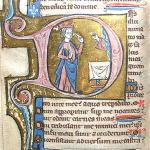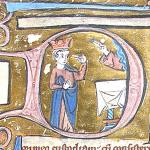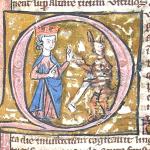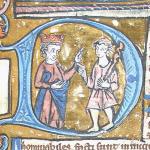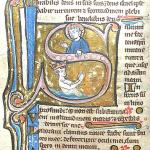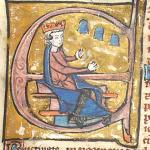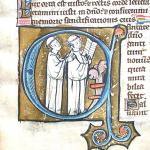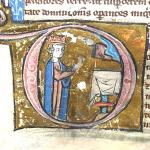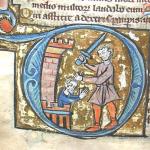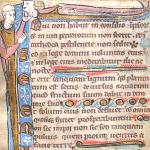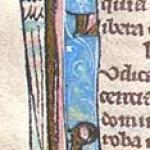PSALTER
Vellum, 5 x 3.75, ff. 174 + 5, 20 lines to a page. 13th cent., well written.
Vellum wrapper.
Given by W. Beale, Master, 1638. 2 fo. qui non.
Collation: 1 flyleaf, 18 - 108 114 128 - 228 (wants 4) 234 (wants 4), 4 flyleaves.
Contents:
Psalter, beginning imperfectly on Ps. i. 1: qui non habiit . . f. 1
Cantica . . . . . . . . . 153b
Litany . . . . . . . . . 167
Office of the Dead . . . . . . . . 168b
Each page has a border on 3 sides, L. top and bottom. It consists of
a band of blue or pink (on alternate pages) on the L. with white patterns
on which the gold initials are set; these are filled with blue or pink. At
top and bottom are bars of blue, gold and pink, with white feather patterns:
these are turned respectively upward and downward at the ends. There
are also historiated initials with gold grounds, viz.:
Dominus illuminatio. David crowned stands pointing to his eye: the Divine Hand
above an altar on R.
Dixit custodiam. Similar.
Quid gloriaris. David crowned: a devil (defaced) with scroll on R.
Dixit insipiens. David crowned: bare-legged fool in tunic with stick on R.
Salvum me fac. Christ above, half-length: David crowned, nude, in water below.
Exultate. David sits playing on three bells hung on R.
Cantate. Two clerks in albs facing R., the one on R. holds book: lectern on R.
Domine exaudi. David faces altar on R. Divine Hand above it.
Dixit dominus. John Baptist kneeling within a battlemented wall at base of a
tower. An executioner on R. beheads him.
A leaf has been cut out of the Litany containing most of the invocations of the Saints. Those which remain are scratched through with a pen. They are legible but do not convey clear information as to the provenance.
The kalendar is also gone.
I have no doubt that the book is from Flanders. It closely resembles one at Trinity College (R.10.5) and I have seen others of the same kind.
